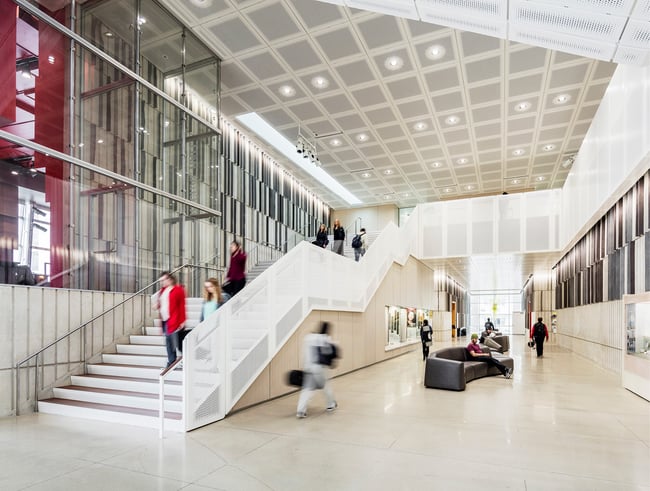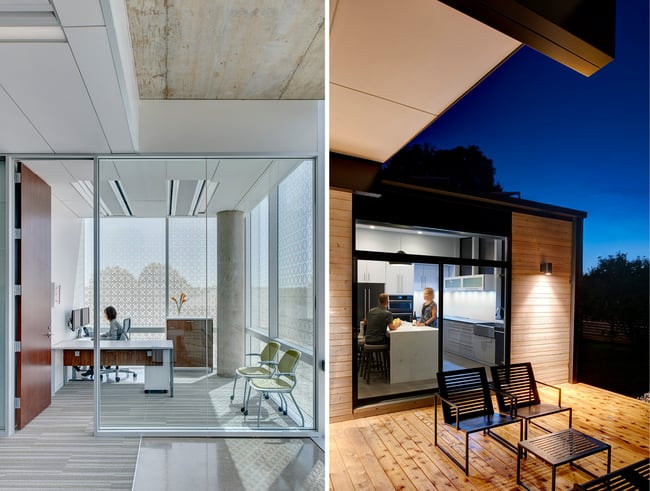What is the Fitwel Building Certification System?

With people spending 90% of their time indoors, the built environment is a crucial determinant of human health. One pathway toward healthier buildings is using a third-party building certification system. Programs like LEED, WELL, and Living Building Challenge (LBC) outline strategies for improving occupants’ physical and mental well-being.
For owners considering a building certification system, another option is Fitwel. Since its start, over 23 million buildings have been certified through the program, including buildings operated by companies like Principal, MetLife, and LinkedIn.
At Neumann Monson, we are always looking to educate owners about sustainable design practices. This article will explain Fitwel, its certification pathways, and its certification process.
What is Fitwel?
Fitwel is a building certification system focused on human health. It was created in partnership with the US Centers for Disease Control (CDC) and Prevention and the US General Services Administration (GSA). Today, the Center for Active Design oversees the program, with the CDC remaining as a research and evaluation partner.
Fitwel’s standards were developed from over 7000 academic studies on public health and building design. This research led to seven overarching principles—called Impact Categories—that improve health within the built environment, including:
- Community Health
- Reducing Morbidity and Absenteeism
- Social Equity for Vulnerable Populations
- Feelings of Well-Being
- Access to Healthy Foods
- Occupant Safety
- Physical Activity
Although Fitwel’s recommended strategies differ across project types, it seeks to fulfill these goals. For example, it encourages development in walkable neighborhoods to increase physical activity and strengthen community health.

Fitwel recommends strategies for physical activity.
Fitwell differs from other building certification systems by lacking prerequisites. The program uses a point system, and projects are evaluated based on how they measure against Fitwel’s standards.
Any building or interior project can seek certification, and Fitwel offers different pathways for new construction, projects in development, and existing spaces. Depending on the number of points achieved, projects can earn one of three star ratings:
- One Star (90-104 points)
- Two Star (105-124 points)
- Three Star (125-144 points)
Its strategies positively impact occupants and provide owners with a Return on Investment (ROI) through reduced absenteeism, increased productivity, and improved occupant satisfaction. It also helps organizations stand out in competitive markets and demonstrate their commitment to well-being and equity.
Fitwel Certification Pathways
Instead of applying an overarching standard to all buildings, Fitwel has scorecards for different project types. This approach leads to strategies tailored to the project’s occupants and function.
Its scorecards include:
- Senior Housing: Focuses on properties providing housing and services for aging residents, including independent living facilities, assisted living facilities, and memory care facilities.
- Multi-Tenant Base Building: Addresses commercial buildings occupied by multiple tenants. The scorecard impacts the spaces controlled by the owner/manager.
- Multi-Tenant Whole Building: Addresses commercial buildings with multiple tenants and applies to all tenant spaces and common areas.
- Single Tenant Building: Focuses on commercial buildings with floors and common areas occupied by a single tenant.
- Commercial Interior Space: Addresses spaces within a commercial building occupied by a single tenant, such as a leased office.
- Retail: Focuses on retail complexes occupied by multiple tenants or spaces within a building occupied by a single retail tenant.
- Multifamily Residential Building: Focuses on residential buildings with multiple units.
Along with its building scorecards, Fitwel provides scorecards for site development. These scorecards include:
- Community: Addresses publicly owned/managed sites that incorporate at least one residential building. It impacts all outdoor and common areas.
- Commercial and Industrial Site: Focuses on sites owned and managed by a single entity and includes commercial buildings only.
Although each scorecard evaluates similar metrics, recommended strategies differ. Each scorecard is tailored to the building or site type to highlight the best practices in each situation.

Fitwel offers scorecards for commercial and residential construction.
As mentioned, Fitwel has no prerequisites. Rather than setting requirements, it evaluates how a project implements its recommended strategies.
Fitwel Certification Process
Fitwel works with a group of consultants experienced in healthy building practices. These consultants evaluate building documentation through a “double-blind review” process in which two independent reviewers assess the project and confirm a numerical score without seeing the other reviewer’s responses. This approach minimizes bias and leads to a more objective evaluation.
Typically, reviews take 12-16 weeks. First, Fitwel will review project documentation and provide comments. Project teams will then resubmit for a final review, and the project will receive a rating.
Like all building certification systems, Fitwel has certification fees based on the project’s square footage. However, costs tend to be lower than other popular certification systems. Explore Fitwel’s pricing page to understand what you may pay.
A Fitwel certification lasts three years, after which projects must reapply to maintain a rating. Like other certification systems, Fitwel is always evolving to reflect new research and practices. Projects reapplying for certification will be judged against the program’s updated standards to ensure the building follows best practices.
Learn More About Sustainable Design
Fitwel provides a path toward improving human health within the built environment. It helps owners implement strategies, track their progress, and make improvements to their buildings and operations.
Compared to other building certification systems, it tends to be more affordable and accessible. Rather than setting requirements, Fitwel evaluates buildings against its standards, making it a good option for owners wanting to make improvements to existing buildings. It can also help owners implement design strategies for new buildings or projects in development.
Before choosing a building certification system, we recommend exploring your options. WELL also focuses on human health and is gaining popularity in the corporate sector. Learn more by reading about WELL strategies in the workplace.